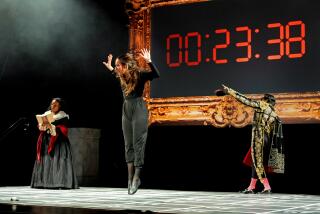Cage’s ‘Living Room Music’ Given Living Room Reading
- Share via
Not long after he had begun banging on cans, John Cage turned to other household items, like sofas and coffee tables. The idea, a charming one in 1940 when war was beginning to engulf the world and whimsy was in short supply, was to show us how music might be made where we least expected it. The piece was “Living Room Music,” and four percussionists tapped away on a stage set of living room furniture.
Sunday afternoon, the tables, so to speak, were turned when the California EAR Unit played Cage’s score in a fancy real living room, that of the airy Familian House. Built by Frank Lloyd Wright disciple John E. Lautner Jr. in 1971, the Beverly Hills private home was the latest concert space for Chamber Music in Historic Sites series that the Da Camera Society of Mount St. Mary’s College puts on.
The towering Familian living room is a wonder. With its floor-to-ceiling angular windows, its stone floor and wood beams, indoors and outdoors meet, and that suited the mostly Californian music of the afternoon just fine.
In fact, the “Living Room Music” was the only mild disappointment of the afternoon. It was very well played (and, in a central movement with a Gertrude Stein text, well chanted) but there was no furniture to tap. There are new owners of the house, and they haven’t yet furnished the room. Instead, the players used two “period” instruments (a wooden chest and a bird cage) and two more modern ones (an art book and a small television set).
An inspiration, though, was programming Cage’s “Child of Tree”--in which amplified cactuses and other plants, or instruments made entirely from plant material, are sonically explored--in an environment where indoor and outdoor ferns feel part of the same space. Arthur Jarvinen, his exceedingly long ponytail gently swaying like an organic metronome, played it lovingly.
Elsewhere on the short program were the last movement from John Adams’ recent violin sonata, “Road Movies” (excitingly performed by the violinist, Robin Lorentz, and the pianist, Vicki Ray, who had premiered it), and Lou Harrison’s First Concerto for flute and percussion (Dorothy Stone was the riveting soloist). The latter was written in 1939 when he and Cage were bringing percussion instruments from the junk yard into the concert hall for the first time, and it, too, was at home in so California a setting.
That such an environment can illuminate music was maybe best illustrated in an overheard remark. The program began with six short transcriptions of medieval music by Charles Wuorinen, and one patron, after the concert, said that while she didn’t normally like modern music, she enjoyed everything except the first piece.
More to Read
The biggest entertainment stories
Get our big stories about Hollywood, film, television, music, arts, culture and more right in your inbox as soon as they publish.
You may occasionally receive promotional content from the Los Angeles Times.











